Research on Multi-Energy Coordinated Intelligent Management Technology of Urban Power Grid Under the Environment of Energy Internet
Abstract
1. Introduction
2. Structure and Typical Characteristics of Urban Energy Internet
3. Multi-Energy Coordination and Optimization Dispatching Strategy of Urban Power Grid
3.1. Integrated Day-Ahead Coordination and Dispatching Model with Large-Scale Intermittent Energy
3.2. Robust Dispatching Method of Renewable Energy
3.3. The Solution of the Model Based on ADMM
4. Example Analysis
4.1. Basic Parameters of Power Grid
4.2. Benefit Analysis of Multi-Energy Coordinated Control
4.3. The Effect of Increased Penetration on Economic Performance
4.4. The Influence of Energy Storage System on the Benefit of the Robust Method
4.5. Influence of Changes of Power Structure on Benefits of the Robust Method
4.6. Influence of New Energy Inverse Peak Regulation on Robust Performance
5. Conclusions
Author Contributions
Funding
Conflicts of Interest
References
- Challenge for the Future Society: Smart Energy Network. Available online: http://www.Tokyo-gas.Co.jp/techno/challenge/002_e.html (accessed on 9 October 2014).
- Huang, A.Q.; Crow, M.L.; Heydt, G.T. The future renewable electric energy delivery and management (FREEDM) system: The energy internet. Proc. IEEE 2011, 99, 133–148. [Google Scholar] [CrossRef]
- Jiang, X.S.; Jing, Z.X.; Li, Y.Z. Modeling and operation optimization of an integrated energy based direct district water-heating system. Energy 2014, 64, 375–388. [Google Scholar] [CrossRef]
- Yu, X.D.; Xu, X.D.; Chen, S.Y. A brief review to integrated energy system and energy internet. Trans. China Electrotech. Soc. 2016, 31, 1–13. [Google Scholar]
- Wang, C.S.; Wang, S.X. Study on some key problems related to distributed generation systems. Autom. Electr. Power Syst. 2008, 32, 32–41. [Google Scholar]
- Xu, X.D. Modeling, Simulation, and Energy Management Research for Electricity, Gas, and Heat Based Micro Energy System. Ph.D. Thesis, Tianjin University, Tianjin, China, November 2014. [Google Scholar]
- Wang, W.L.; Wang, D.; Jia, H.J. Review of Steady-state Analysis of Typical Regional Integrated Energy System Under the Background of Energy Interne. Proc. CSEE 2016, 36, 3292–3305. [Google Scholar]
- GRID2030-a National Vision for Electricity’s Second 100 Years [EB/OL]. Available online: http://www.ferc.gov/eventcalendar/files/20050608125055-grid-2030.pdf (accessed on 9 October 2014).
- Dong, Z.; Zhao, J.; Wen, F. From smart grid to energy internet: Basic concept and research framework. Autom. Electr. Power Syst. 2014, 38, 1–11. [Google Scholar]
- Han, X.Y.; Chai, Y.F.; Zhang, Y. Analysis of Several Key Issues in Construction of the Urban Energy Internet. Electr. Power Constr. 2018, 39, 138–146. [Google Scholar]
- Bejestani, A.K.; Annaswamy, A.; Samad, T. A hierarchical transactive control architecture for renewables integration in smart grids: Analytical modeling and stability. IEEE Trans. Smart Grid 2014, 5, 2054–2065. [Google Scholar] [CrossRef]
- Wang, L.X.; Zheng, J.H.; Li, M.S. Multi-time scale dynamic analysis of integrated energy systems: An individual-based model. Appl. Energy 2019, 237, 848–861. [Google Scholar] [CrossRef]
- Wang, H.; Yin, W.; Abdollahi, E. Modelling and optimization of CHP based district heating system with renewable energy production and energy storage. Appl. Energy 2015, 159, 401–421. [Google Scholar] [CrossRef]
- Chen, Y.; Jia, K.; Liu, B. Energy management method applying in integrated energy system. In Proceedings of the International Conference on Electric Utility Deregulation & Restructuring & Power Technologies, Changsha, China, 26–29 November 2015. [Google Scholar]
- Mohammadi, F. Design, Analysis, and Electrification of a Solar-Powered Electric Vehicle. J. Sol. Energy Res. 2018, 3, 293–299. [Google Scholar]
- Mu, Y.; Wu, J.; Jenkins, N. A Spatial-Temporal model for grid impact analysis of plug-in electric vehicles. Appl. Energy 2014, 114, 456–465. [Google Scholar] [CrossRef]
- Martinezmares, A.; Fuerteesquivel, C.R. A Unified Gas and Power Flow Analysis in Natural Gas and Electricity Coupled Networks. IEEE Trans. Power Syst. 2012, 27, 2156–2166. [Google Scholar] [CrossRef]
- Duenas, P.; Leung, T.; Gil, M. Gas–Electricity Coordination in Competitive Markets Under Renewable Energy Uncertainty. IEEE Trans. Power Syst. 2015, 30, 123–131. [Google Scholar] [CrossRef]
- Lei, J.Y.; Yu, L.; Guo, X.B. Planning Method for Integrated Energy System with the Consideration of Coupling among Power, Heat, and Gas. Proc. Csu-Epsa 2019, 1, 19–24. [Google Scholar]
- Stanislav, P.; Bryan, K.; Tihomir, M. Smart Grids better with integrated energy system. In Proceedings of the Electrical Power & Energy Conference, Montreal, QC, Canada, 22–23 October 2009. [Google Scholar]
- Jia, H.J.; Wang, D.; Wang, X.D. Research on Some Key Problems Related to Integrated Energy Systems. Autom. Electr. Power Syst. 2015, 39, 198–207. [Google Scholar]
- Kenji. Reactive power optimization by genetic algorithm. IEEE Trans. Power Syst. 1994, 9, 685–692. [Google Scholar] [CrossRef]
- Pakazad, S.K.; Hansson, A.; Annergren, M.S. Distributed primal-dual interior-point methods for solving loosely coupled problems using message passing. Optim. Methods Softw. 2015, 32, 401–435. [Google Scholar] [CrossRef]
- Jones, C.N.; Kerrigan, E.C.; Maciejowski, J.M. Lexicographic perturbation for multiparametric linear programming with applications to control. Automatic 2007, 43, 1808–1816. [Google Scholar] [CrossRef]
- Kong, X.Y.; Ma, Y.Y.; Zhao, X.; Li, Y.; Teng, Y.X. A Recursive Least Squares Method with Double-Parameter for Online Estimation of Electric Meter Errors. Energies 2019, 12, 805. [Google Scholar] [CrossRef]
- Jun, Z.; Yan, W.; Dan, W. Research Progress in Energy Internet: Definition, Indicator and Research Method. Proc. Csu-Epsa 2018, 10, 1–14. [Google Scholar]
- Kong, X.; Bai, L.; Hu, Q. Day-ahead optimal scheduling method for grid-connected microgrid based on energy storage control strategy. J. Mod. Power Syst. Clean Energy 2016, 4, 648–658. [Google Scholar] [CrossRef]
- Wang, Y.C.; Chen, H.Y.; Xuan, P.Z. A Robust Scheduling with Multiple Types of Power Sources Based on Optimal Scenario Set. Power Syst. Technol. 2016, 40, 354–362. [Google Scholar]
- Bai, L.; Li, F.; Cui, H. Interval optimization based operating strategy for gas-electricity integrated energy systems considering demand response and wind uncertainty. Appl. Energy 2016, 167, 270–279. [Google Scholar] [CrossRef]
- Yong, C.S.; Kong, X.Y.; Chen, Y. Multi-objective Scheduling of an Active Distribution Network Based on Coordinated Optimization of Source Network Load. Appl. Sci. 2018, 8, 1888. [Google Scholar] [CrossRef]
- Gao, H.; Xue, L.Y. Back Propagation Neural Network Based on Improved Genetic Algorithm Fitting LED Spectral Model. Laser Optoelectron. Prog. 2017, 54, 294–302. [Google Scholar]
- Bai, L.; Wang, J.; Wang, C. Distribution Locational Marginal Pricing (DLMP) for Congestion Management and Voltage Support. IEEE Trans. Power Syst. 2017. [Google Scholar] [CrossRef]
- Jambagi, A.; Kramer, M.; Cheng, V. Electricity and Heat Sector Coupling for Domestic Energy Systems: Benefits of Integrated Energy System Modelling. In Proceedings of the 4th International Conference on Smart Cities & Green Ice Systems, Lisbon, Portugal, 15 October 2015. [Google Scholar]
- Mohammadi, F. Power Management Strategy in Multi-Terminal VSC-HVDC System. In Proceedings of the 4th National Conference on Applied Research in Electrical, Mechanical, Computer and IT Engineering, Tehran, Iran, 4 October 2018. [Google Scholar]
- Wu, H.Y.; Guan, X.H.; Zhai, Q.Z. Short-term Hydrothermal Scheduling Using Mixed-integer Linear Programming. Proc. CSEE 2009, 29, 82–88. [Google Scholar]
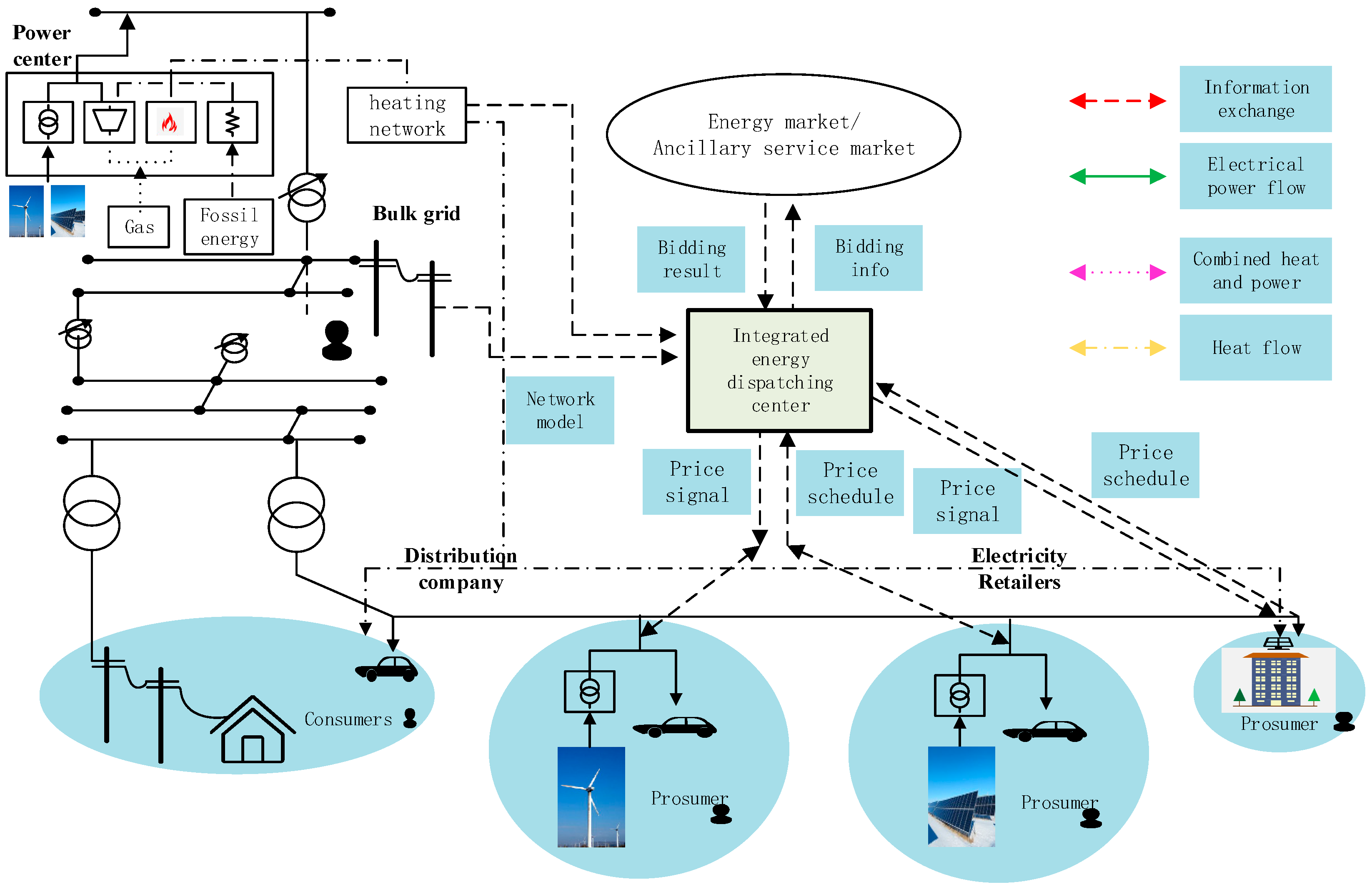
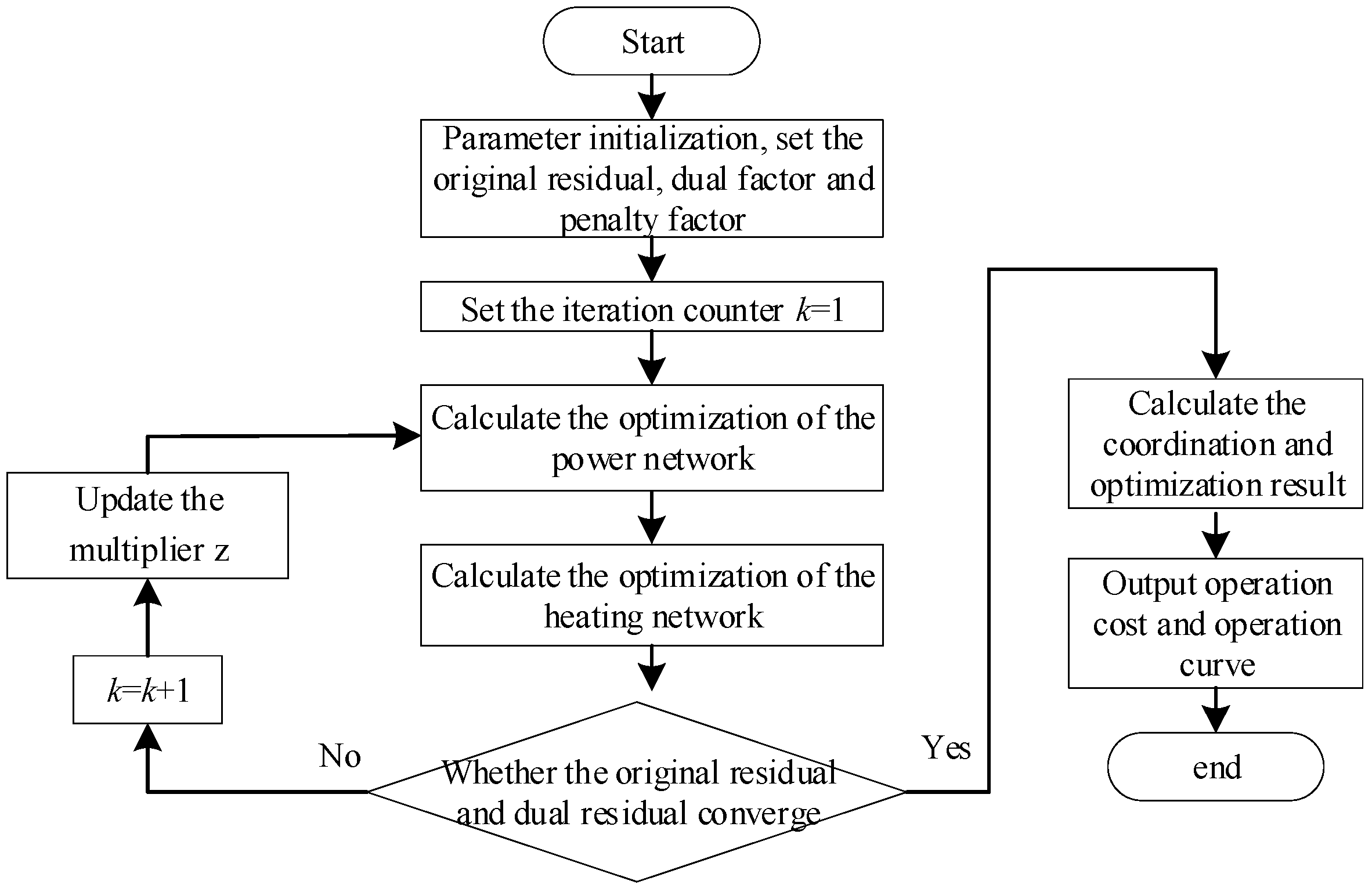
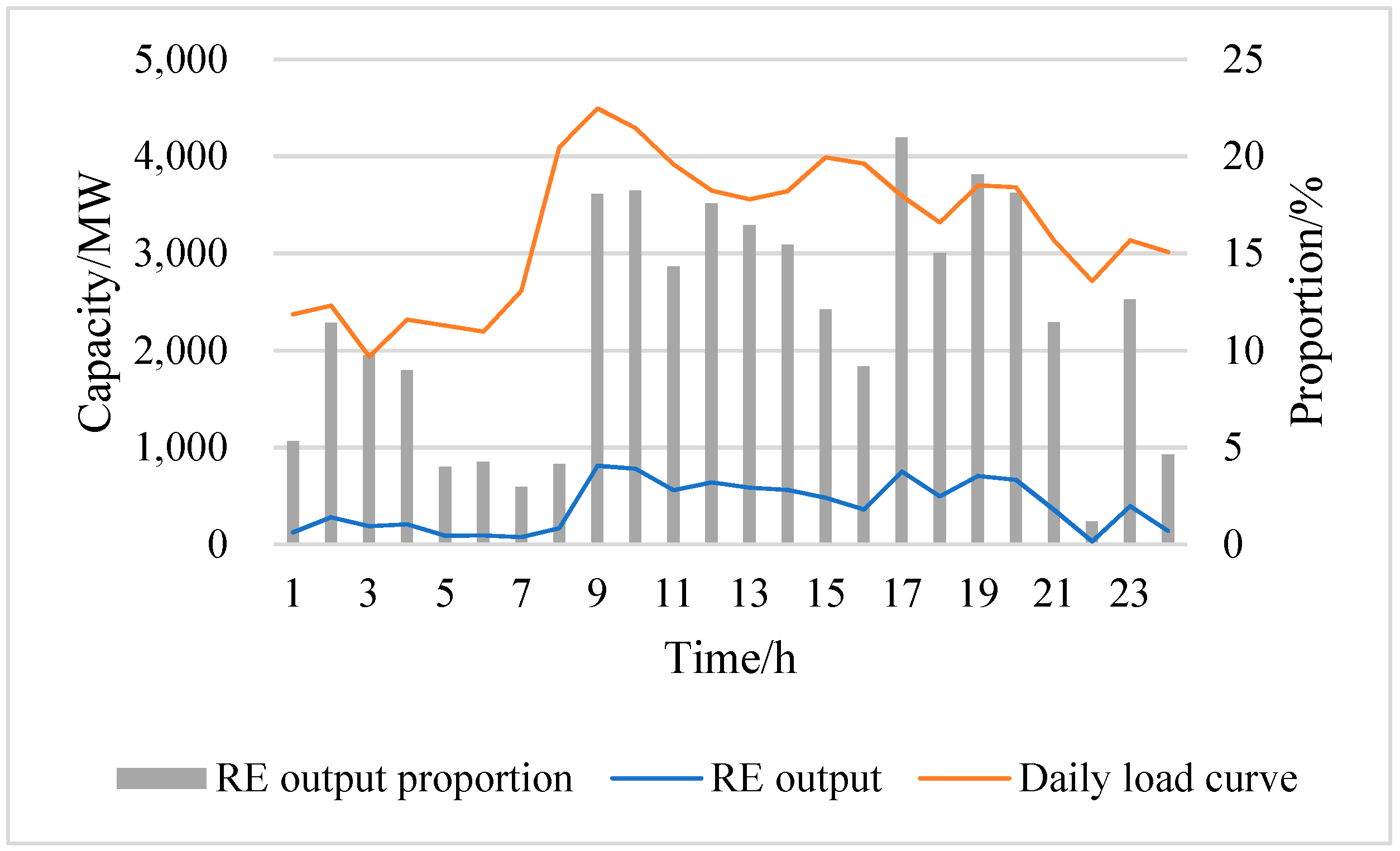
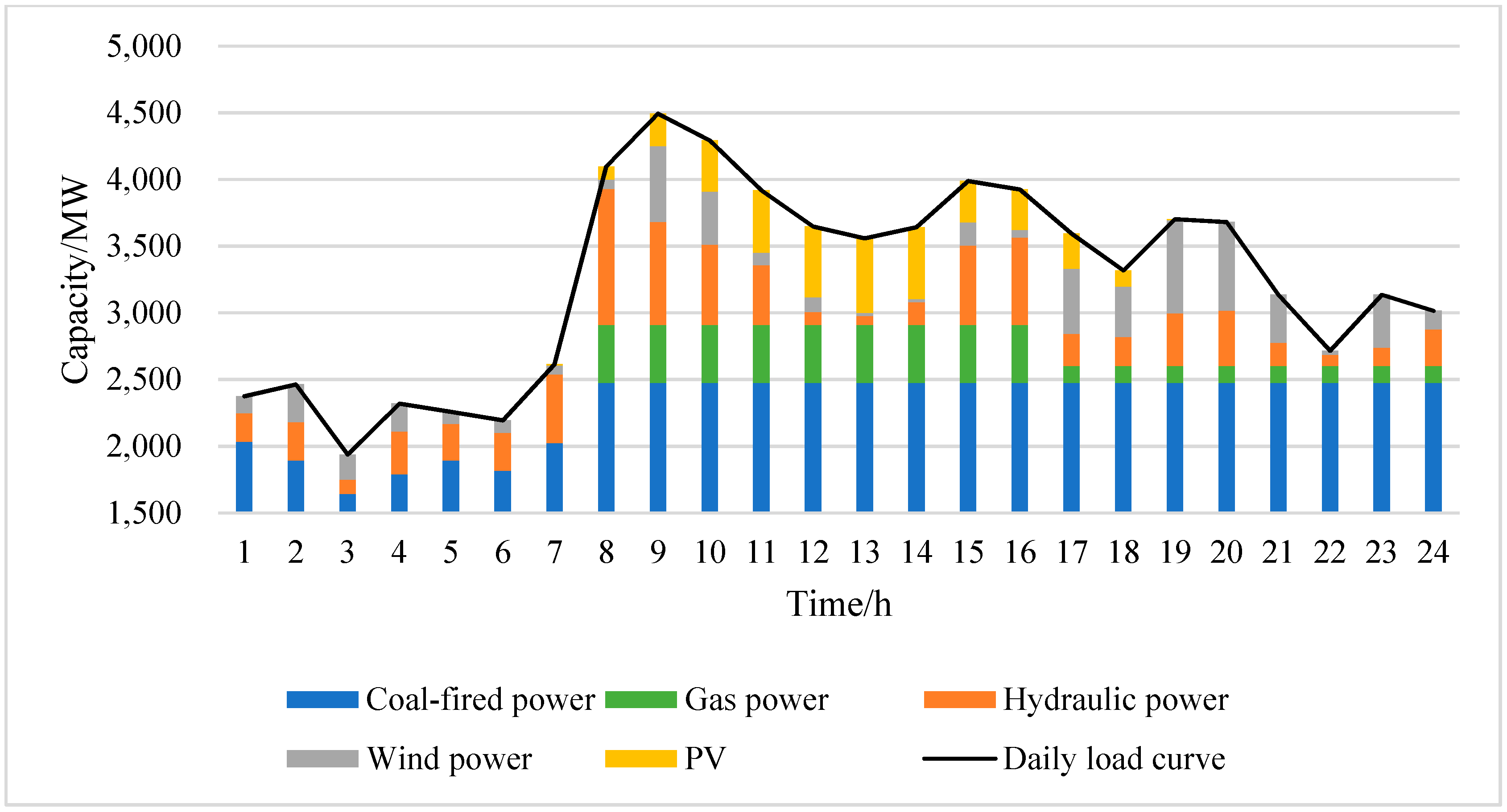
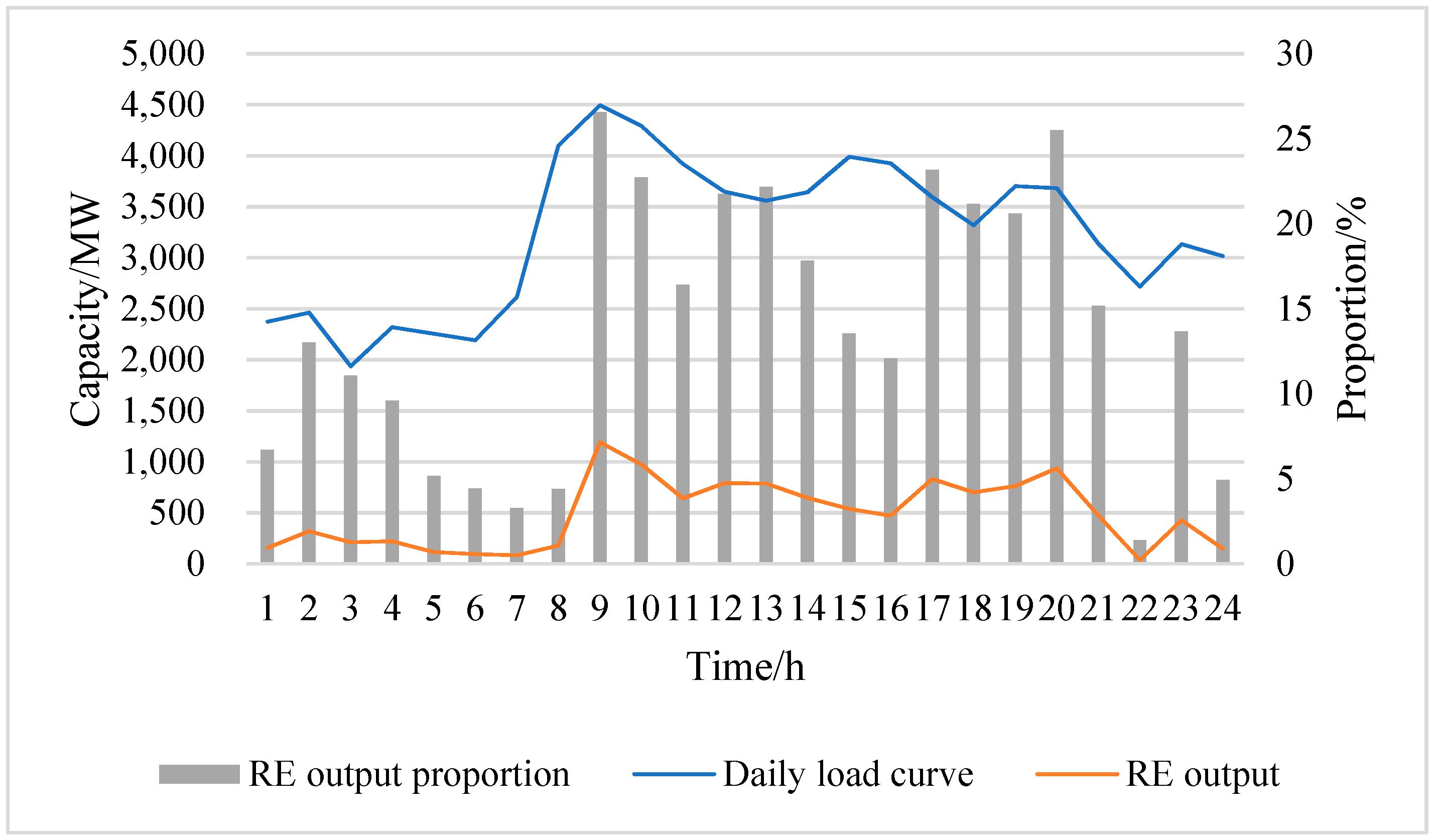

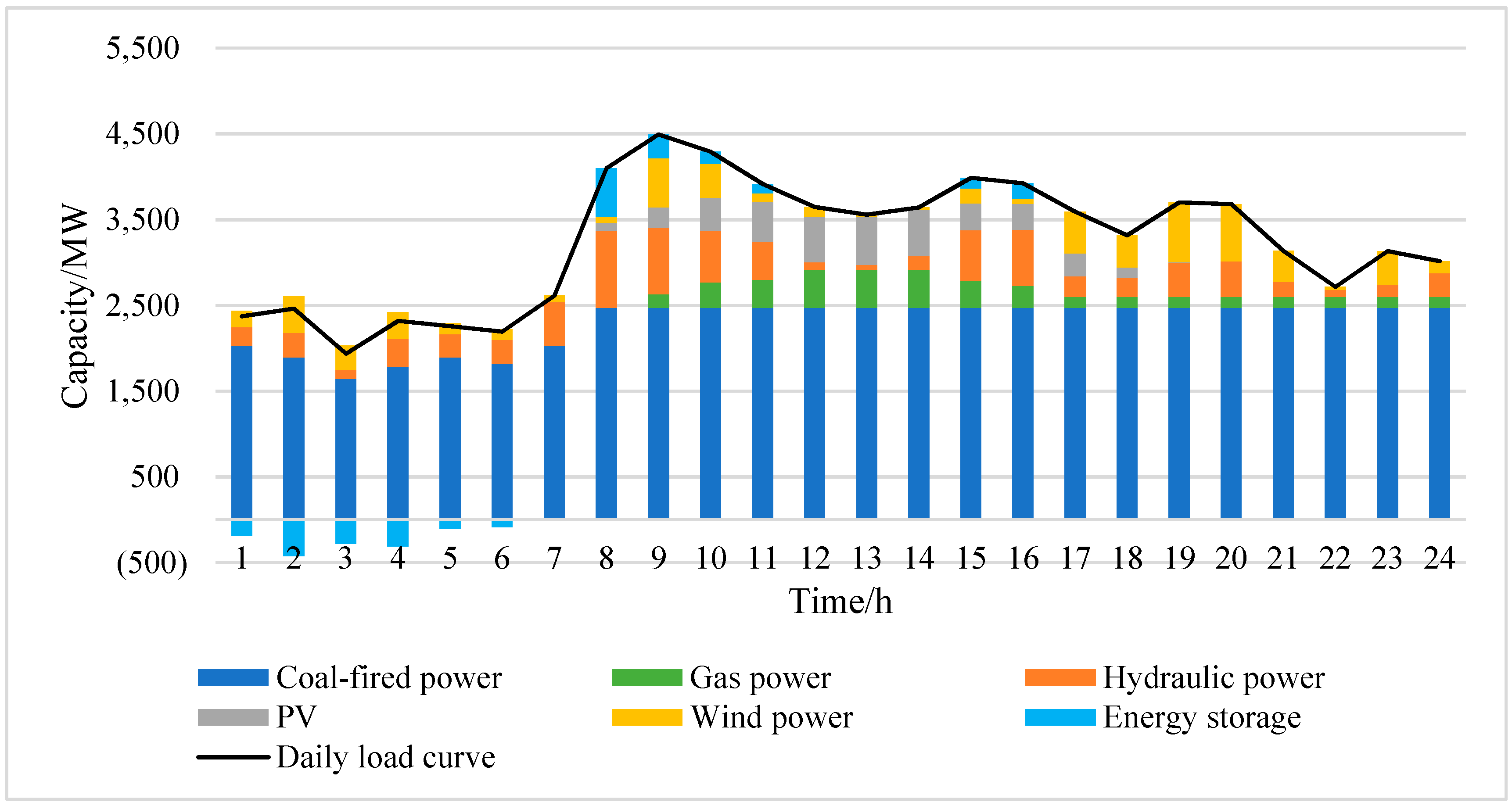
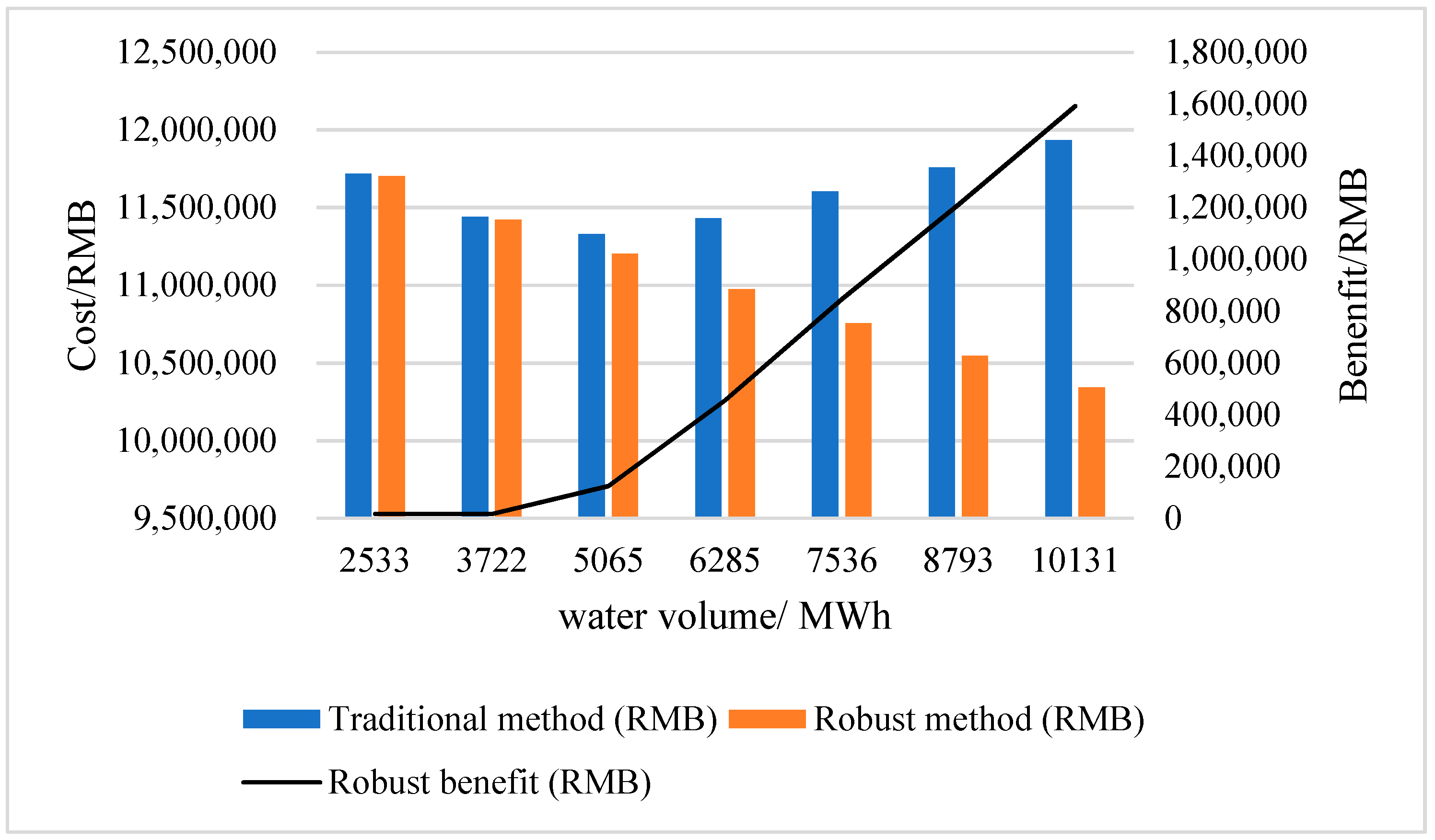
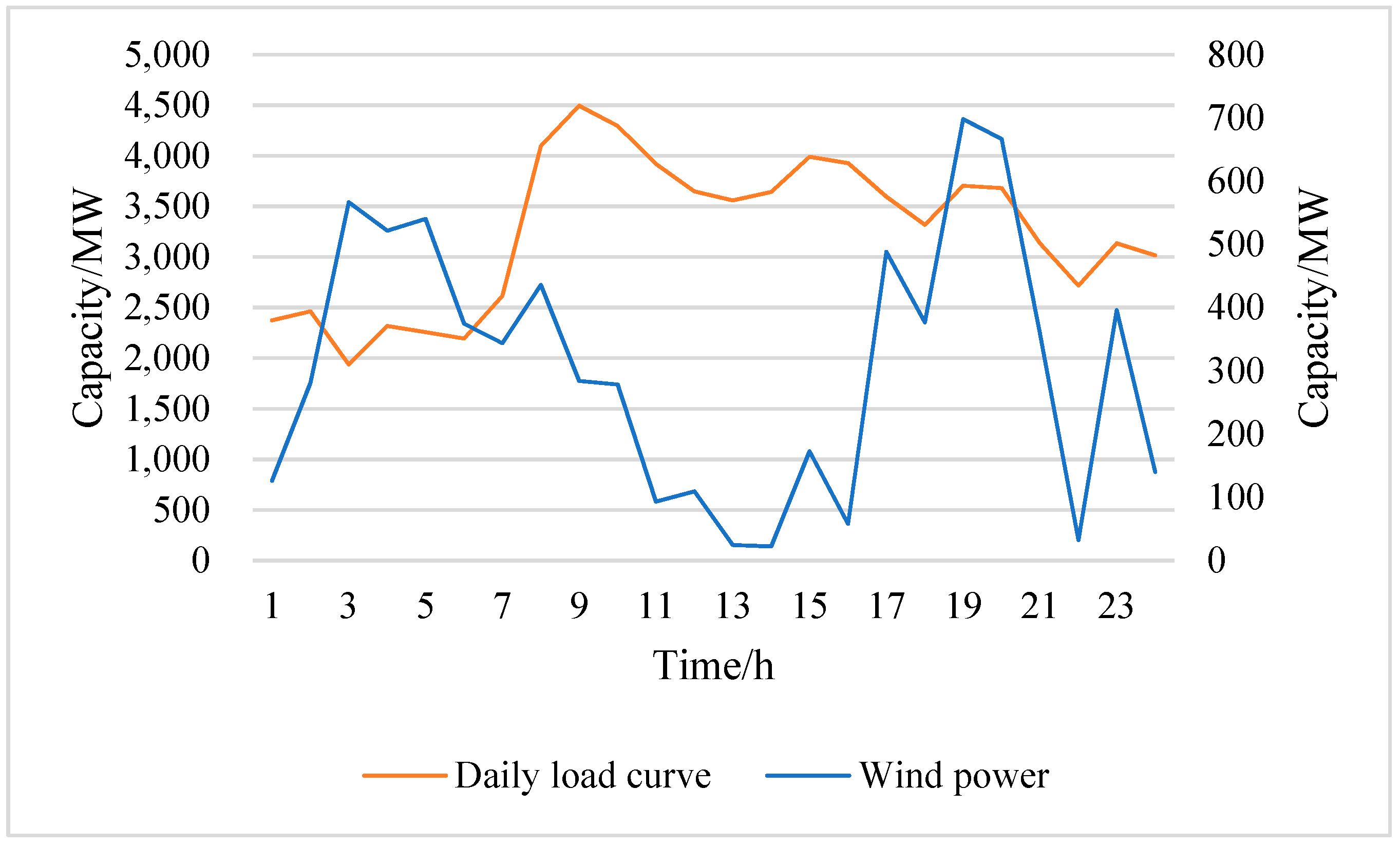
| Power Source Type | Wind Power | PV | Coal | Gas | Hydraulic | Total |
|---|---|---|---|---|---|---|
| Capacity (MW) | 976.0 | 700.0 | 2474.0 | 497.6 | 800.0 | 5447.6 |
| The percentage | 17.92% | 12.85% | 45.41% | 9.13% | 14.69% | 100% |
| Wind/Light Curtailment (MWh) | Cutting Load (MWh) | The Cost of Risk (RMB) | Environmental Costs (RMB) | Power Generation Cost (RMB) | Comprehensive Cost (RMB) | |
|---|---|---|---|---|---|---|
| The traditional method | 141.6 | 0.685 | 66,889.8 | 1,999,128.1 | 8,202,832.4 | 10,268,850.3 |
| The robust method | 141.6 | 0.078 | 36,682.1 | 1,988,924.1 | 8,227,298.8 | 10,252,905 |
| Difference | 0.023 | 0.606 | 30,207.7 | 10,204 | −24,466.4 | 15,945.3 |
| The Proportion | 20% | 25% | 30% | 35% | 45% | 55% |
| Comprehensive cost (RMB) | 10,559,895.1 | 10,049,988.8 | 10,019,681.4 | 10,056,537.7 | 10,475,301.1 | 11,576,782.2 |
| Penetrance | The Fluctuation of Peak-Load New Energy (MW) | Rotational Reserve | Risk–Benefit (RMB) | Environmental Benefits (RMB) | Operation Efficiency (RMB) | Comprehensive Benefits (RMB) |
|---|---|---|---|---|---|---|
| 18.4% | 179.7 | 13.8% | 29,315.7 | 10,325.9 | −24,702.6 | 14,939 |
| 36.8% | 323.5 | 29.2% | 490,167.7 | 8128.4 | −78,763.6 | 419,532.5 |
| Difference | 143.8 | 15.4% | 460,852 | −2197.5 | −54,061 | 404,593.5 |
| The Fluctuation of Peak-Load New Energy (MW) | Rotational Reserve | Risk–Benefit (RMB) | Environmental Benefits (RMB) | Operation Efficiency (RMB) | Comprehensive Benefits (RMB) | |
|---|---|---|---|---|---|---|
| No energy storage system | 209.9 | 16.1% | 34,422 | 11,963 | −28,617 | 17,768 |
| With energy storage system | 162.6 | 12.3% | 96,482 | 56,891 | −68,285 | 85,088 |
| Difference | −47.3 | −3.7% | 62,060 | 44,928 | −39,668 | 67,320 |
| Water volume (MW∙h) | 2533 | 3722 | 5065 | 6285 | 7536 | 8793 | 10,131 |
| Traditional method (kRMB) | 11,600 | 11,324 | 11,213 | 11,316 | 11,486 | 11,641 | 11,814 |
| Robust method (kRMB) | 11,584 | 11,307 | 11,089 | 10,865 | 10,649 | 10,440 | 10,238 |
| Robust benefit (RMB) | 16,725 | 16,600 | 123,841 | 451,610 | 838,316 | 1,200,501 | 1,575,818 |
| Wind/Light Curtailment Reduction (MWh) | Load Cutting Reduction (MWh) | Risk–Benefit (RMB) | Environmental Benefits (RMB) | Operation Benefit (RMB) | Comprehensive Benefits (RMB) | |
|---|---|---|---|---|---|---|
| Down load | 4.561 | 0.636 | 30,616.66 | 10,597.26 | −25,622.79 | 15,591.13 |
| Inverse peak shaving | 127.548 | 2.686 | 162,635.3 | 5926.7 | −31,936.46 | 136,625.59 |
| Difference value (inverse-cis) | 132.109 | 2.050 | 132,018.6 | −4670.56 | −6313.67 | 121,034.46 |
© 2019 by the authors. Licensee MDPI, Basel, Switzerland. This article is an open access article distributed under the terms and conditions of the Creative Commons Attribution (CC BY) license (http://creativecommons.org/licenses/by/4.0/).
Share and Cite
Wang, X.; Kong, X.; E, Z.; Sun, F.; Zhang, C. Research on Multi-Energy Coordinated Intelligent Management Technology of Urban Power Grid Under the Environment of Energy Internet. Appl. Sci. 2019, 9, 2608. https://doi.org/10.3390/app9132608
Wang X, Kong X, E Z, Sun F, Zhang C. Research on Multi-Energy Coordinated Intelligent Management Technology of Urban Power Grid Under the Environment of Energy Internet. Applied Sciences. 2019; 9(13):2608. https://doi.org/10.3390/app9132608
Chicago/Turabian StyleWang, Xin, Xiangyu Kong, Zhijun E, Fangyuan Sun, and Changzhi Zhang. 2019. "Research on Multi-Energy Coordinated Intelligent Management Technology of Urban Power Grid Under the Environment of Energy Internet" Applied Sciences 9, no. 13: 2608. https://doi.org/10.3390/app9132608
APA StyleWang, X., Kong, X., E, Z., Sun, F., & Zhang, C. (2019). Research on Multi-Energy Coordinated Intelligent Management Technology of Urban Power Grid Under the Environment of Energy Internet. Applied Sciences, 9(13), 2608. https://doi.org/10.3390/app9132608




